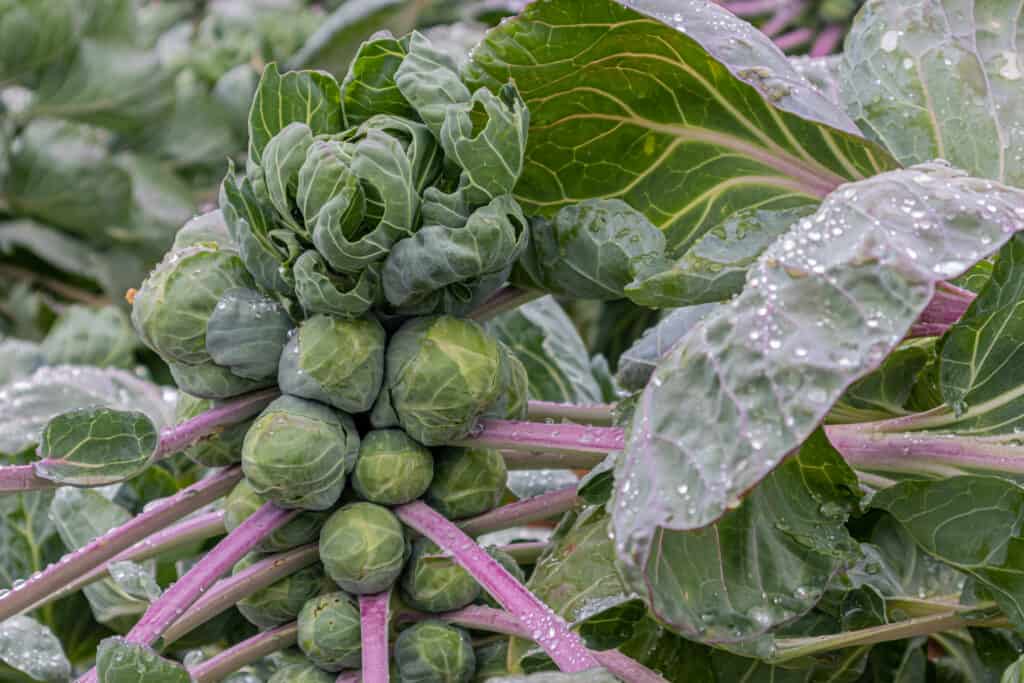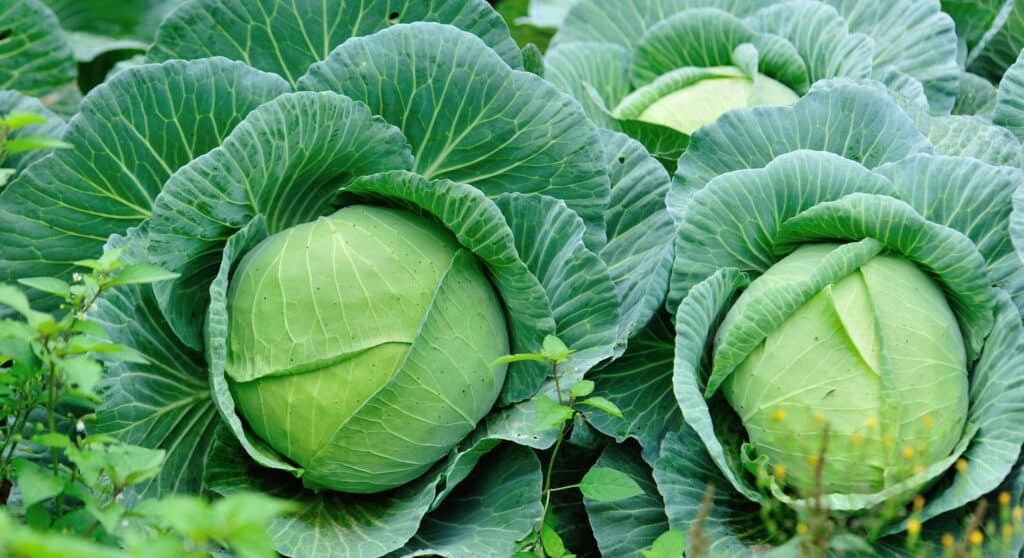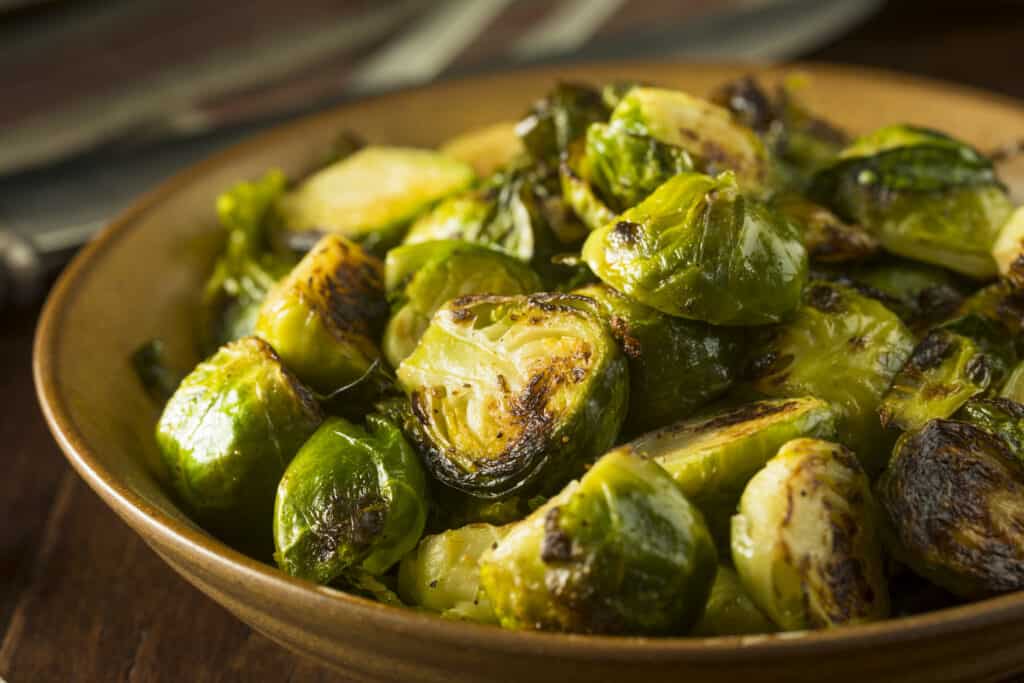What’s the difference between Brussels sprouts and cabbage? Both are cruciferous vegetables, which means they’re part of the Brassica family, along with cauliflower, broccoli, and kale. They’re both packed with nutrients, but there are some key differences between them.
Brussels sprouts are small, round, and green and look a bit like miniature cabbages. They’re often sold still on the stalk and have a slightly bitter taste. Cabbage, on the other hand, is larger, tougher, and has a milder flavor. It can be white, green, or red and is often used in salads or as a cooked vegetable.
So, which one should you eat? Brussels sprouts are a great choice if you’re looking for a nutrient-packed vegetable that will boost your immune system. Cabbage is a good option if you’re looking for a vegetable that will help you stay regular. Both are great choices, so eat them both!
Let’s discover the differences between Brussels sprouts and what makes these delicious vegetables so good for you.
Comparing Brussels Sprouts and Cabbage
| Brussels Sprout | Cabbage | |
|---|---|---|
| Classification | Species: Brassica oleracea Cultivar group: Gemmifera Group | Species: Brassica oleracea Cultivar group: Capitata Group |
| Origin | Native to the Mediterranean | Exact origin unknown, but varieties of Brassica oleracea are native to Europe and Britain. |
| Plant Type | Biennial | Annual |
| Description | Brussels sprouts are small 1-inch buds that grow on a stalk. They have overlapping green leaves with a pungent smell during cooking. | Cabbage are heads with thick, rubbery, green leaves. It grows out of the ground and softens when cooked. |
| Uses | Edible vegetables with a high nutritional value. High in fiber, antioxidants, and vitamins A, C, and K. | Edible vegetable with a high nutritional value. High in fiber, antioxidants, and vitamins C and K. |
| How to Grow | – Plant in the summer with full sunlight – Use loamy, well-draining soil – Seeds need to be 24 inches apart and half an inch deep – Grow in 45 – 80 degrees Fahrenheit – Neutral pH | – Plant in the spring or fall in full sunlight – Use loamy, well-draining soil – Plant seeds 18 inches apart and ¼ inches deep – Grow in 60 – 65 degrees Fahrenheit – Acidic, neutral pH |
Brussels Sprout vs. Cabbage: Classification and Origin
Brussels sprouts and cabbage are members of the same family, the Brassica, along with collard greens, turnips, kale, broccoli, and bok choy. Cabbages are heads that grow out of the ground, and Brussels sprouts are buds that grow on a thick stalk.
Brussels sprouts got their name from Brussels, Belgium. They are members of cabbage’s ‘Gemmifera’ cultivar group and are grown for their nutrient-dense edible buds. They are native to the Mediterranean region and found their way to northern Europe sometime in the 5th century. However, the first written reference for Brussels sprouts dates back to 1587 and became highly popular in the southern Netherlands and Northern Europe in the 16th century.
Cabbage is a descendant of wild cabbage and is related to cauliflower, broccoli, and Brussels sprouts. It consists of various cultivars of Brassica oleracea and is a biennial plant grown as an annual vegetable. Cabbage dated back to around 1,000 BC in Europe and was popular in European cuisine during the Middle Ages. During the Renaissance, new variants of cabbage were introduced and became a staple throughout Europe by the 17th century.

Brussels sprouts got their name from Brussels, Belgium. They are nutrient-dense edible buds.
©mm7/Shutterstock.com
Brussels Sprout vs. Cabbage: Description
Brussels sprouts are green, leafy vegetables that look like miniature cabbages, and the plant can grow to about 2.5 feet tall. Large Brussels sprouts are about 0.6 – 1.6 inches in diameter and grow on a stem in the leaf axis. Did you know that each stalk has between 20 and 40 sprouts? Harvest 5 – 15 at a time for an extended harvest!
Like Brussels sprouts, cabbage has a rubbery texture that softens when cooked. The outer leaves’ color of cabbage range from a dark to pale green, and the more you peel away at the cabbage leaves, the lighter they become. When choosing a cabbage at the store, go for one that is heavier than others and leaves that are tightly bound.

The outer leaves of cabbage range from dark to pale green, with lighter shades found towards the center.
©iStock.com/lzf
Brussels Sprouts vs. Cabbage: Uses
We grow both Brussels sprouts and cabbages for food. They both get cooked and softened to add flavor and nutrients to a meal. They also contain protein, fiber, potassium, and vitamins A, C, and K.
Brussels sprouts have a higher nutritional content than cabbage. They contain:
- Twice as much vitamin C.
- 52% more dietary fiber.
- 9% higher in protein.
- Lower carbs, with brussels sprouts having 5.8 grams per 100 grams and cabbage having 9 grams per 100 grams.
- Higher niacin and thiamin.
You can’t help but notice the smell when cooking Brussels sprouts and cabbage. This is because they contain the mineral sulfur, which gets released when cooking. If you want to reduce the smell, consider cooking them quickly. You can also expect Brussels sprouts to be more bitter than cabbage due to the compound glucosinolate — the sulfur-containing compound. Even with the slight differences in taste, they are good substitutions for each other.
Health Benefits of Brussels sprouts:
- They are rich in vitamin K, which is essential for bone health and blood clotting.
- High in antioxidants to prevent cell damage.
- Relieves constipation.
- Decrease the risk of diabetes and can help manage blood sugar levels.
- Improve immune system health.
Health benefits of cabbage:
- Rich in vitamin K for bone health and blood clotting.
- It contains antioxidants to reduce inflammation.
- Helps improve digestion.
- Keeps your heart healthy.
- It can lower blood pressure and cholesterol.

Brussels sprouts soften as they are cooked and are high in fiber, antioxidants, as well as vitamins A, C, and K.
©Brent Hofacker/Shutterstock.com
Brussels Sprouts vs. Cabbage: How to Grow
How to Grow Brussel Sprouts
Brussels sprouts are biennial plants with slow-growing seasons but can grow as an annual. The best time to plant them is in the summer, and harvest in the fall or winter. They require loamy, well-draining soil with a neutral pH.
Growing Brussels sprouts tips:
- Plant in full sunlight.
- Plant seeds 24 inches apart and half an inch deep.
- Keep soil moist with about 1 inch of water each week.
- Grow in 45 – 80 degrees Fahrenheit.
How to Grow Cabbage
Cabbage is an annual plant and is a cool-season vegetable. Therefore, the best time to grow them is spring, and it is ready for harvest in about 70 days. Cabbage grows best in well-draining, loamy soil with a neutral pH.
Growing cabbage tips:
- Plant in full sunlight.
- Plant seeds 18 inches apart and ¼ inches deep.
- Keep cabbage crisp with consistent watering.
- Grow in 60 – 65 degrees Fahrenheit.

Brussels sprouts can grow to about 2.5 feet tall with each stalk having between 20 and 40 sprouts.
©Anton Havelaar/Shutterstock.com
Final Thoughts
When it comes to leafy greens, there are a lot of options to choose from. But if you’re looking for a veggie that’s both tasty and nutritious, you can’t go wrong with Brussels sprouts or cabbage. Both of these veggies have loads of vitamins and minerals, and they’re low in calories to boot. Regarding nutrition, Brussels sprouts and cabbage are excellent sources of vitamins A, C, and K. They’re also a great source of fiber, which can help keep you full and satisfied after eating.
If you’re looking for something with a bit more nutritional punch — go for Brussels sprouts. But if you’re simply looking for a delicious and healthy option, either veggie will do the trick!
The photo featured at the top of this post is © iStock.com/Carmen Hauser
Sources
- Wikipedia, Available here: https://en.wikipedia.org/wiki/Brussels_sprout
- Wikipedia, Available here: https://en.wikipedia.org/wiki/Cabbage
- Soupersage, Available here: https://www.soupersage.com/compare-nutrition/cabbage-vs-brussels-sprouts
- The University of Maine, Available here: https://extension.umaine.edu/publications/4182e/
- Healthline, Available here: https://www.healthline.com/nutrition/benefits-of-brussels-sprouts#1
- Healthline, Available here: https://www.healthline.com/nutrition/benefits-of-cabbage#TOC_TITLE_HDR_10
FAQs (Frequently Asked Questions)
Are Brussels sprouts good for you?
Brussels sprouts and other cruciferous veggies are packed with nutrients and are good for your health.
Are Brussels sprouts and cabbage the same thing?
Brussels sprouts and cabbage are of the same species (Brassica oleracea) but in different cultivar groups.
Can I substitute Brussels sprouts with cabbage?
Yes! Cabbage is a great substitute for Brussels sprouts because they have similar flavors and textures.
Do you rinse off Brussels sprouts before cooking?
It is important to rinse or soak Brussels sprouts well before cooking. You can also trim the bottom and remove the outer leaves.
Thank you for reading! Have some feedback for us? Contact the AZ Animals editorial team.






